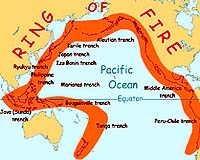| . |  |
. |
Hong Kong (AFP) Oct 1, 2009 Asia trembled this week as earthquakes hit in Indonesia and the South Pacific along the "Ring of Fire," a stretch of seismic fury responsible for most of the world's tremors and volcanoes. But experts said that although one earthquake can sometimes can set off another, that was not the case in this week's disasters which struck Indonesia's Sumatra and the once-idyllic Samoan islands. "They were 10,000 kilometres (6,200 miles) apart," said Bill Fry, a seismologist at GNS Science in New Zealand, of Tuesday's 8.0-magnitude quake in Samoa and a 7.6 tremor the following day in Padang city in Sumatra. "You can get quakes that are close temporally and spatially as one transfers stress to another place against the fault, but that's not possible this far apart," he told AFP. Earthquake frequency needs to be studied over a period of thousands of years to establish patterns, Fry said, and it was impossible to draw conclusions about a cluster of seismic events occurring over a short time. "The frequency at which we have large quakes over a period of days, or even weeks and months, is quite chaotic," he said. The Ring of Fire reaches from Indonesia to the coast of Chile in a 40,000 kilometre (25,000 mile) arc of seismic violence that unleashes earthquakes and volcanoes around the Pacific rim almost every day. Both Padang and Samoa lie on collision points on the Australian tectonic plate, but on different fault zones. Professor Gary Gibson, from the Royal Melbourne Institute of Technology's Seismology Research Centre in Australia, said it was impossible to draw any connection between the two events. "There is no known mechanism to connect them," he told AFP. "What's happening is perfectly normal... Earthquakes often seem to cluster more than they actually do but that is mainly just a psychological perception because you get a big one and then become more alert to others." Geologists are concerned that the city of Padang, where authorities believe thousands have been killed in the disaster, is vulnerable to more earthquakes and tsunamis, and that elsewhere there could be volcanic activity. "There are three big volcanoes in West Sumatra -- Merapi, Talang and Tandikat. We fear that this quake might cause volcanic eruptions there," Geological Disaster Mitigation and Volcanology Centre head Surono told AFP. Padang lies on the same tectonic faultline that cracked off Aceh, at the northern tip of Sumatra, in 2004 to trigger the Indian Ocean tsunami that killed more than 220,000 people. The earthquake that hit Samoa this week, the islands' worst in nearly a century, set off a tsunami that killed at least 148 people and left scores more missing. Share This Article With Planet Earth
Related Links Tectonic Science and News
 Major quakes can weaken seismic faults far away, scientists say
Major quakes can weaken seismic faults far away, scientists sayParis (AFP) Sept 30, 2009 Huge earthquakes can weaken seismic faults on the other side of the world, scientists in California said on Wednesday. Their study coincided with a major 8.0-magnitude quake in the Pacific, unleashing a tsunami that killed scores of people in the Samoan islands and Tonga. Seismologists led by Taka'aki Taira of the University of California at Berkeley found that the 9.1 monster that struc ... read more |
|
| The content herein, unless otherwise known to be public domain, are Copyright 1995-2009 - SpaceDaily. AFP and UPI Wire Stories are copyright Agence France-Presse and United Press International. ESA Portal Reports are copyright European Space Agency. All NASA sourced material is public domain. Additional copyrights may apply in whole or part to other bona fide parties. Advertising does not imply endorsement,agreement or approval of any opinions, statements or information provided by SpaceDaily on any Web page published or hosted by SpaceDaily. Privacy Statement |